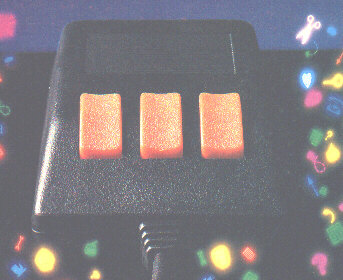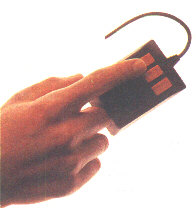AMX Mouse
As a spectrum user you
already enjoy some pretty sophisticated equipment. Let's face it, there's not much joy in a joystick, and keyboards can be all fingers and Thumbs. Frustrating, especially if your imagination is much faster than your fingers! What you need is an AMX
Mouse. The AMX Mouse brings to
Spectrum users the same freedom and versatility which
has, up to now, been the exclusive province of much more
expensive computers. AMX ART - Making full use of on-screen windows, ions, pull-down menus and pointers, you'll be astonished at the quality of the work you can produce, save and print using either ZX or Epson compatible printers. AMX COLOUR PALETTE - The wonderful pictures you create with AMX ART can be brought vividly to life with rich vibrant colours. AMX CONTROL - Now you can create a `Mouse' environment in your own programs, AMX Control adds 28 commands to normal Sinclair Basic. There is also a growing list of programs available from other leading software houses, which also utilize the Mouse, including, Artist II and The Writer from Softechnics, and Art Studio from British Telecom's Rainbird software collection, and many more titles will be available soon. Isn't it about lime you trapped an AMX Mouse? The following review was taken from Sinclair User November 1986 AMS produces what is easily the most comprehensive mouse package for the Spectrum - the AMX. It's been around for more than a year and is regarded by many software houses as the standard mouse for their database, spreadsheets and graphics packages. Rainbird has taken this attitude with Art Studio and Softechnics, which currently favours the Kempston mouse, is about to take a nibble at AMX in Aitist II. It's the best dressed
mouse in town with a rugged, easy to grip, body, a long
lead which connects to a flat, Kempston-like interface.
The interface includes a Cenfronics printer interface
which can be controlled with four AMX Basic instructions.
AMX Art gives more
control over its mouse hardware than any of the other
packages on the market - which isn't surprising. Screen pictures can be saved to and loaded from tape or Microdrive. You can store your own effects or load in screens from professional programs. The package displays all
screens in black, white or shade. While paint-and-play is an addictive occupation, particularly with a mouse, you'll soon want to control the AMX in your own programs - won't you ! The AMX Control Program
extends Basic to incorporate mouse orientated commands.
There are 23 commands which create menus, find out which
menu options have been clicked, choose type fonts,
display icons, set mouse sensitivity and define screen
windows. It you have problems with the technical side of mouse usage you can load the demonstration program on the second side of the AMS cassette. It shows the type of applications which can be written and shows the considerable power of the package. A four-function calculator and sliding puzzle are written in Basic but for speed and type of application they could equally have been written in machine code. Even my jaundiced eye could not tell the difference. |
| [ Main Page ] [ Features ] |

 The package comes with four artist
packages, the simplest of which is AMX Art. Its
similar to Rainbirds Art Studio but the icons are
displayed at the side of the screen and the three click
buttons are programmed. Execute menu option. Leave
menu option and Move mouse, and Cancel last
order.
The package comes with four artist
packages, the simplest of which is AMX Art. Its
similar to Rainbirds Art Studio but the icons are
displayed at the side of the screen and the three click
buttons are programmed. Execute menu option. Leave
menu option and Move mouse, and Cancel last
order.